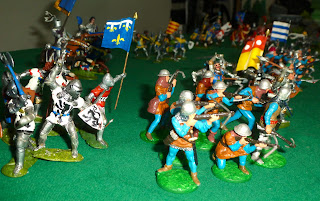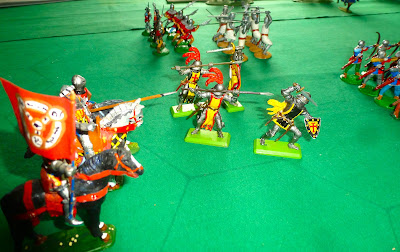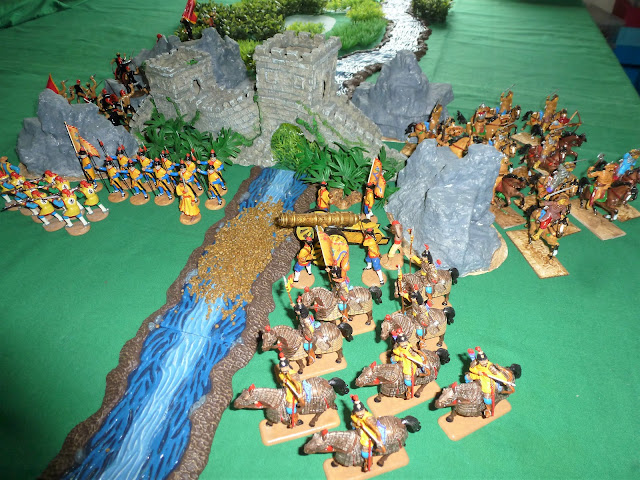You never know what will turn up at the PW Show each year, it's a perfect mélange of toy soldiers, all scales large and small, collectable rarities rub shoulders with terrible tat, it's anybody's game and it's always a lot of fun. I never go with any expectation of what I might find, mostly I'm looking out for figures to flesh out my 54mm toy soldier wargame armies and this year there was a bumper crop of Medievals:
When I have a little money, I buy Toy Soldiers; and if I have any left, I buy food and clothes. (with apologies to:) ERASMUS
Saturday, 20 September 2025
A Medieval host at the Plastic Warrior Show 2025
Wednesday, 21 May 2025
Lionheart - more playing with old toy knights.
Our first trial game of Lionheart worked very well so we decided to expand on it by introducing some terrain elements and and an additional two unit types; Heavy Foot Knights and Mercenaries. The remainder of the armies were the same as in our previous game and we increased the number of actions in each turn from four to six per side. The basic game mechanics were explained in my previous post HERE.
Wednesday, 7 May 2025
Britains American War of Independance Swoppets.
This past year I embarked upon a review of how I store and display the unruly mass of toy soldiers accumulated in a largely haphazard way over the past six plus decades.
Wednesday, 16 August 2023
Feast and Famine.
We're already heading towards the end of the car boot season, and this year the pickings have been very thin, but last weekend there was a bumper crop:
Tuesday, 11 January 2022
Honved infantry for the Risorgimento
Or at least my take on them. I've been sitting on a pile of Airfix Napoleonic French Line infantry and Grenadiers which I've been steadily trying to find other uses for, I got bored with painting French uniforms a long time ago!
Saturday, 26 September 2020
Not Quite Victorious Army
But I'm sure they will be when they eventually get onto the table for a game!
For some time now I've been building up a generic Chinese army, I'm not sure why and I can't remember how it started, perhaps I just like the colours. And the flags, the flags are great. Anyway, there is no grand plan, I just bang out another unit every now and then when an idea comes to me, it's quite therapeutic, doing something different. Here's what I've got so far:
Tuesday, 19 November 2019
Stuart Asquith's Big Wars - Battle of Tanga 1914
A fun game, quick and easy to master, and a good scenario for solo play as there isn't much scope for tactical movement. I playtested the rules quite a bit when they first came out in 1993 and used them in a "play by email" game that I hosted a few years ago (see Big Wars link in right hand column) but apart from that they've been rather overlooked, perhaps it's time they got a bit more of a regular outing.
In 1914 the IEF outnumbered the Schutztruppe by 8 to 1 so, not unnaturally, the British Staff believed the battle would be a walkover. The Navy were ordered not to support the attack so that the town might be taken intact for use by the occupying force, for the same reason the IEF mountain batteries were not landed. The result was that the entire IEF was evacuated on 5th November leaving most of their equipment behind, perhaps not the most ignominious feat of British arms, but well up there.




























.JPG)
.JPG)




















